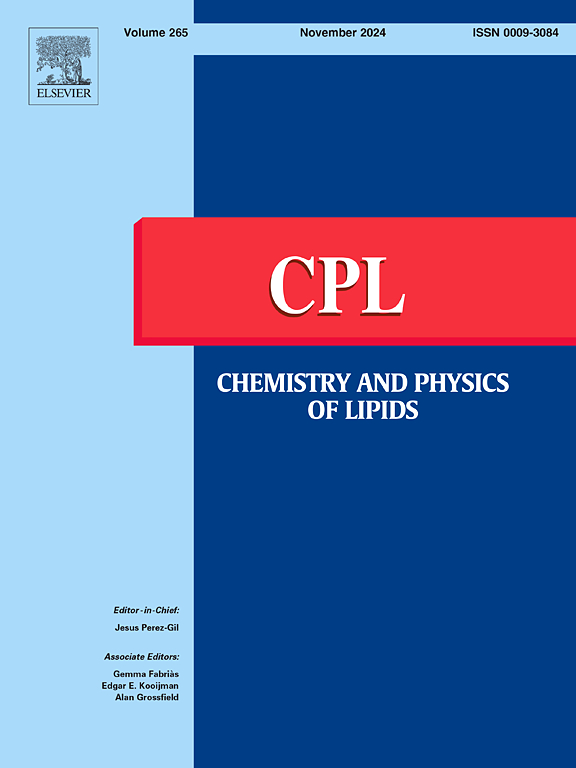Interaction of biomimetic lipid membranes with detergents with different physicochemical characteristics
IF 2.8
3区 生物学
Q2 BIOCHEMISTRY & MOLECULAR BIOLOGY
引用次数: 0
Abstract
Membrane solubilization by detergents is routinely performed to separate membrane components, and to extract and purify membrane proteins. This process depends both on the characteristics of the detergent and properties of the membrane. Here we investigate the interaction of eight detergents with very distinct physicochemical features with model membranes in different biologically relevant phases. The detergents chosen were the non-ionic Triton X-100, Triton X-165, C10E5, octyl glucopyranoside (OG) and dodecyl maltoside (DDM) and the ionic sodium dodecyl sulfate (SDS), cetyl trimethyl ammonium bromide (CTAB) and Chaps. Three lipid compositions were explored: pure palmitoyl oleoyl phosphatidylcholine (POPC), in the liquid-disordered (Ld) phase, sphingomyelin (SM)/cholesterol 7:3 (chol) in the liquid-ordered (Lo) phase and the biomimetic POPC/SM/chol 2:1:2, which might exhibit Lo/Ld phase separation. Turbidity measurements of small liposomes were performed along the titration with the detergents to obtain the overall solubilization profiles and optical microscopy of giant unilamellar vesicles (GUVs) was used to reveal the mechanism of interaction of the detergents. The presence of cholesterol renders the membranes partly/fully insoluble in all detergents, and the charged detergents are the least effective to solubilize POPC. The non-ionic detergents, with exception of DDM, with the bulkiest headgroup, caused a substantial increase in surface area of POPC, which was quantified directly on single GUVs. The other detergents induced mainly vesicle burst. Detergents that caused some increase in area induced Lo/Ld phase separation in the ternary mixture, with preferential solubilization of the latter. The insoluble area fraction left intact was quantified. Overall, the non-ionic detergents were the most effective in solubilizing lipid membranes.
仿生脂膜与不同理化性质洗涤剂的相互作用。
通常使用洗涤剂对膜进行增溶,以分离膜组分,提取和纯化膜蛋白。这一过程取决于洗涤剂的特性和膜的性能。在这里,我们研究了八种具有不同物理化学特征的洗涤剂与不同生物相关相的模型膜的相互作用。选用非离子型Triton X-100、Triton X-165、C10E5、辛基葡萄糖苷(OG)和十二烷基麦芽糖苷(DDM)以及离子型十二烷基硫酸钠(SDS)、十六烷基三甲基溴化铵(CTAB)和Chaps。研究了三种脂质组成:液体无序相(Ld)中纯棕榈酰油酰磷脂酰胆碱(POPC),液体有序相(Lo)中鞘磷脂(SM)/胆固醇7:3 (chol),以及可能表现Lo/Ld相分离的仿生POPC/SM/chol 2:1:2。在滴定过程中,通过测量小脂质体的浊度来获得洗涤剂的整体增溶情况,并通过光学显微镜观察巨型单层囊泡(GUVs)来揭示洗涤剂相互作用的机制。胆固醇的存在使膜部分/完全不溶于所有洗涤剂,而带电洗涤剂对POPC的溶解效果最差。除DDM外,头基最大的非离子型洗涤剂使POPC的表面积显著增加,这是在单个guv上直接量化的。其他洗涤剂主要引起囊泡破裂。导致面积增加的洗涤剂会导致三元混合物中Lo/Ld相分离,后者优先增溶。对不溶性面积分数进行定量分析。总的来说,非离子洗涤剂在溶解脂质膜方面是最有效的。
本文章由计算机程序翻译,如有差异,请以英文原文为准。
求助全文
约1分钟内获得全文
求助全文
来源期刊

Chemistry and Physics of Lipids
生物-生化与分子生物学
CiteScore
7.60
自引率
2.90%
发文量
50
审稿时长
40 days
期刊介绍:
Chemistry and Physics of Lipids publishes research papers and review articles on chemical and physical aspects of lipids with primary emphasis on the relationship of these properties to biological functions and to biomedical applications.
Accordingly, the journal covers: advances in synthetic and analytical lipid methodology; mass-spectrometry of lipids; chemical and physical characterisation of isolated structures; thermodynamics, phase behaviour, topology and dynamics of lipid assemblies; physicochemical studies into lipid-lipid and lipid-protein interactions in lipoproteins and in natural and model membranes; movement of lipids within, across and between membranes; intracellular lipid transfer; structure-function relationships and the nature of lipid-derived second messengers; chemical, physical and functional alterations of lipids induced by free radicals; enzymatic and non-enzymatic mechanisms of lipid peroxidation in cells, tissues, biofluids; oxidative lipidomics; and the role of lipids in the regulation of membrane-dependent biological processes.
 求助内容:
求助内容: 应助结果提醒方式:
应助结果提醒方式:


